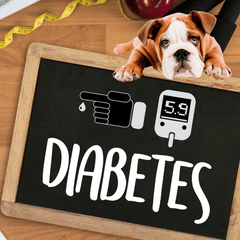Save Money, Save Your Dog.
Join Our Email List For Discounted Pricing and a Free Guide to the Science of Keto Dog Food.
Diabetes is a debilitating and potentially deadly disease for dogs. And while thoughtful and motivated pet parents can manage it effectively, that process will usually prove costly and labor-intensive. It is, unquestionably, a serious problem.
Treatment is possible, and we talk about in "10 Facts You Need To Know About Diabetes In Dogs". It is vital that pet parents try to catch it early and immediately start taking corrective action.
And that's why I'm writing this article. My hope is that it will help you identify the signs and symptoms of canine diabetes early, so that you can make the appropriate changes to your dog's life as quickly as possible if she is in fact suffering from the disease.

Now, before we launch into the five most important symptoms of diabetes in dogs, two quick prefatory notes.
First, understand that diabetes is most often a disease that dogs develop as adults. (The average age of diagnosis is 9 to 10 years.) While early-onset cases exist, they are quite rare. So just because your dog didn't show any of the signs of diabetes over the first few years of her life doesn't mean she's in the clear.
Second, understand that a definitive diagnosis will require your veterinarian's judgment. The defining characteristic of diabetes is an inability to produce sufficient quantities of the metabolic hormone insulin. And there are a variety of tests your vet can run -- some direct and others indirect -- that will help her determine whether or not your dog's insulin levels are normal.
But testing won't happen unless you bring the matter to your vet's attention first. Naturally, that's something you can only do if you know what signs and symptoms to look out for. And that's where this article comes in.
1) Increased Thirst and Urination

A more easily observed symptom of canine diabetes is increased water consumption and urination.
One of the hallmarks of canine diabetes is that dogs with diabetes tend to urinate more. Why this happens is actually quite straightforward: some glucose can be excreted in urine, so when your dog's body senses consistently-elevated blood glucose levels, it uses urination as a kind of safety valve to dump as much of the excess as possible.
Increased urination means a loss of water. And this dehydration leads to greater thirst, which is observable to the naked eye as increased water consumption. This is why a marked uptick in water consumption is a diabetes red flag.
Since the amount of water consumed each day isn't always obvious (and since your dog probably isn't great at verbally expressing concepts like "thirst"), monitoring urination habits is usually easier. If your dog has been asking to be let out more frequently than usual or if a housebroken dog has begun have accidents inside the home, that's an important warning sign.
2) Lethargy and Reduce Activity

Diabetes is a metabolic disease and metabolism is the process by which your dog produces the energy her body needs to power its daily activities. So diabetic dogs tend to be somewhat less active than they would be in a healthy state.
It can be difficult to determine whether a slow-down is the result of disease or simply a natural byproduct of aging. So consider it in context. If your dog is also showing one of the other hallmarks of diabetes, that probably warrants a trip to the veterinarian. When it comes to diabetes -- a disease that can kill if left untreated -- it is probably better to be safe than sorry.
3) Weight Loss

This is a weird one.
In humans, there is a well-established link between obesity and Type II diabetes. The reason for the association depends on who you ask -- some folks believe that the same dietary habits that give rise to obesity also give rise to diabetes, while others believe that obesity itself actually causes diabetes.
But the signal to be watchful for in your dog is actually weight loss, not weight gain. Here, again, the explanation is pretty straightforward: insulin's "job" is to pull circulating nutrients into bodily tissues like fat and muscle, so an insulin deficiency causes nutrients to go unabsorbed. Because the food your dog eats isn't actually finding its way into her bodily tissues, those tissues slowly but surely waste away. Ergo, weight loss.
As with lethargy, weight loss is common in aging dogs regardless of whether or not they are diabetic. So, again, context is key. If weight loss is accompanied by any of the other signs and symptoms of diabetes, that's likely grounds for a vet visit.
4) Cataracts and Vision Loss

Last but not least, be watchful for cloudy eyes and blurred vision. In humans, cataracts are some five times as common in diabetics as in the broader population. Similar studies haven't been performed with dogs, but most veterinary textbooks claim that cataracts are far more common in diabetic dogs too.
At this point there isn't great consensus as to why this association exists (here's a paper that discusses some potential mechanisms). But that's not really necessary for our purposes anyway. If your dog has gradually developed cataracts, a precautionary trip to the vet is probably a good use of your time.
5) High Blood Sugar

This is where any discussion of the signs and symptoms of canine diabetes must begin.
The primary function of insulin is to regulate your dog's blood glucose ("sugar") levels. More specifically, the hormone helps prevent glucose levels from getting too high after carbohydrate-rich meals. As such, dogs with untreated diabetes almost always wind up with excessive amounts of glucose in their blood and urine.
Is this something you can monitor at home? Yes, but only if you have the right tools. Specifically, you'll need a device called a glucometer. Glucometers measure the amount of glucose in the blood plasma by analyzing a small droplet, usually drawn using a light skin prick.
A 2009 study showed that glucometers optimized for use with dogs are not always accurate. But they're relatively widely used and can be obtained for about $50 and without a veterinary subscription.
I'm not in a place to endorse any one glucometer over others, but here's a link to someone else's discussion of the costs and benefits of some of the more popular glucometers currently on the market.
If you're willing to live on the cutting edge a bit, another option is to use a continuous glucose monitor. These new devices live on the skin and generate blood glucose data throughout the day, obviating the need for regular skin pricks. And although they're sold for human use, a recent study suggests that glucose monitoring systems are very reliable when measuring canine glucose levels too.
In either case, persistent glucose readings above 8-9 mmol/l (144-162 mg/dl) are a red flag that should probably prompt a trip to the vet.
--
So that's it for now. I hope this article helps you understand how to spot canine diabetes early and immediately take appropriate action. If you want to learn more about diabetes in dogs (including recommended foods, an evaluation of the relevant science, and more), I suggest you check out my lengthy "Guide to Diabetes in Dogs" -- it's packed with practical tips. And if you want a low-carbohydrate kibble to help manage your dog's diabetes, I humbly suggest Ketona.
Thanks for reading and good luck!


Related Articles
How Much Does The Farmer’s Dog Really Cost?
Learning to Take Pleasure In Being Your Dog's Play Buddy-Drill Sargeant
Dogs, Dog Food and Dogma - A Book About America's Pet Obesity Epidemic
A Step-By-Step Guide to Using a Continuous Glucose Monitor (CGM) With Your Dog
Browse Articles By Category